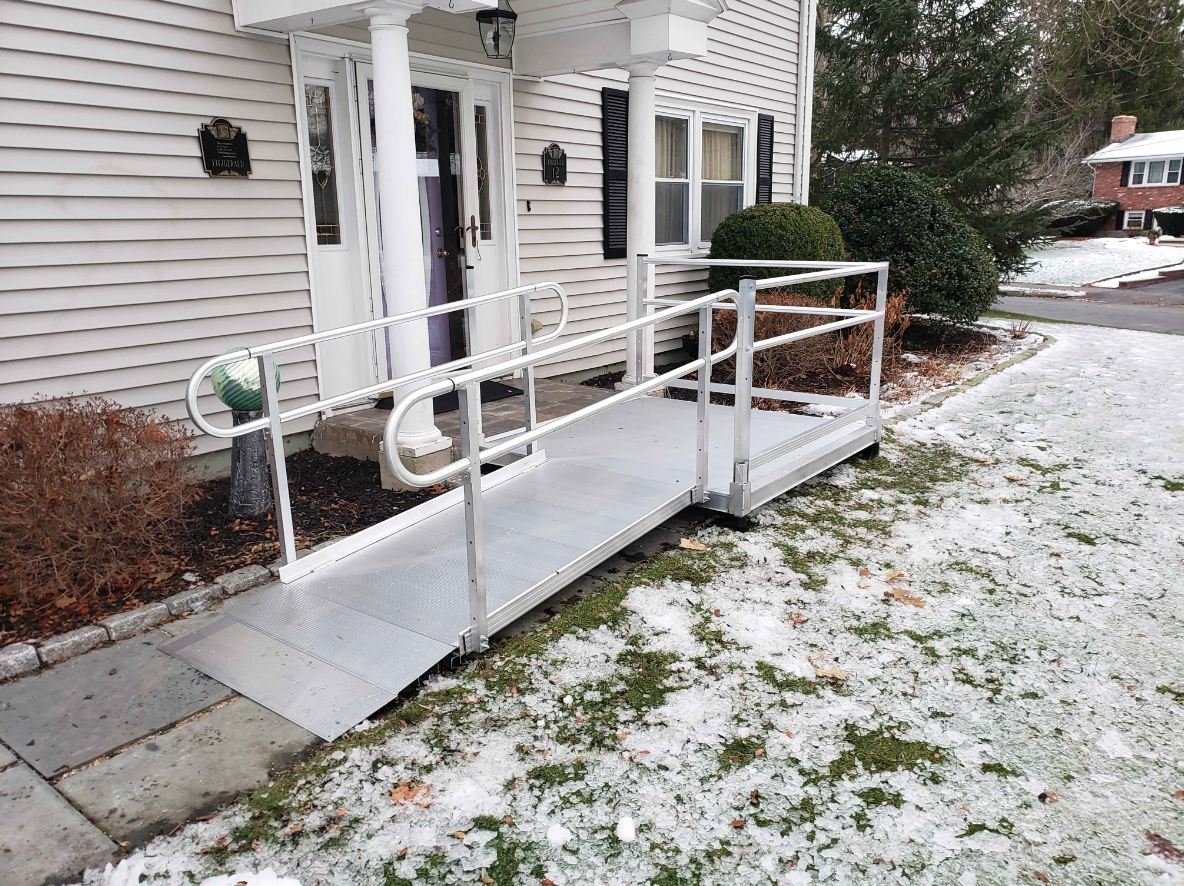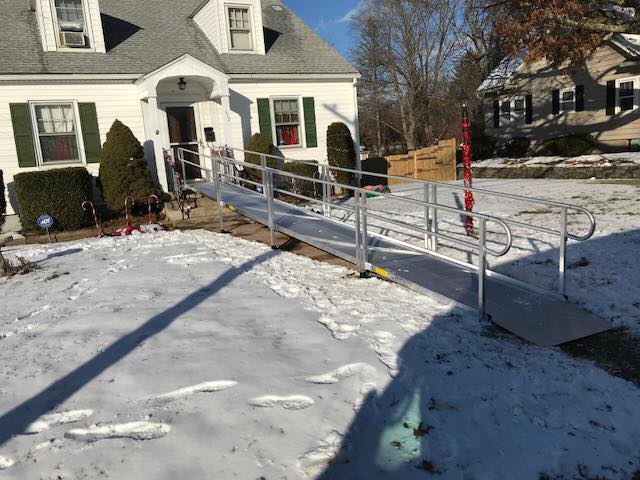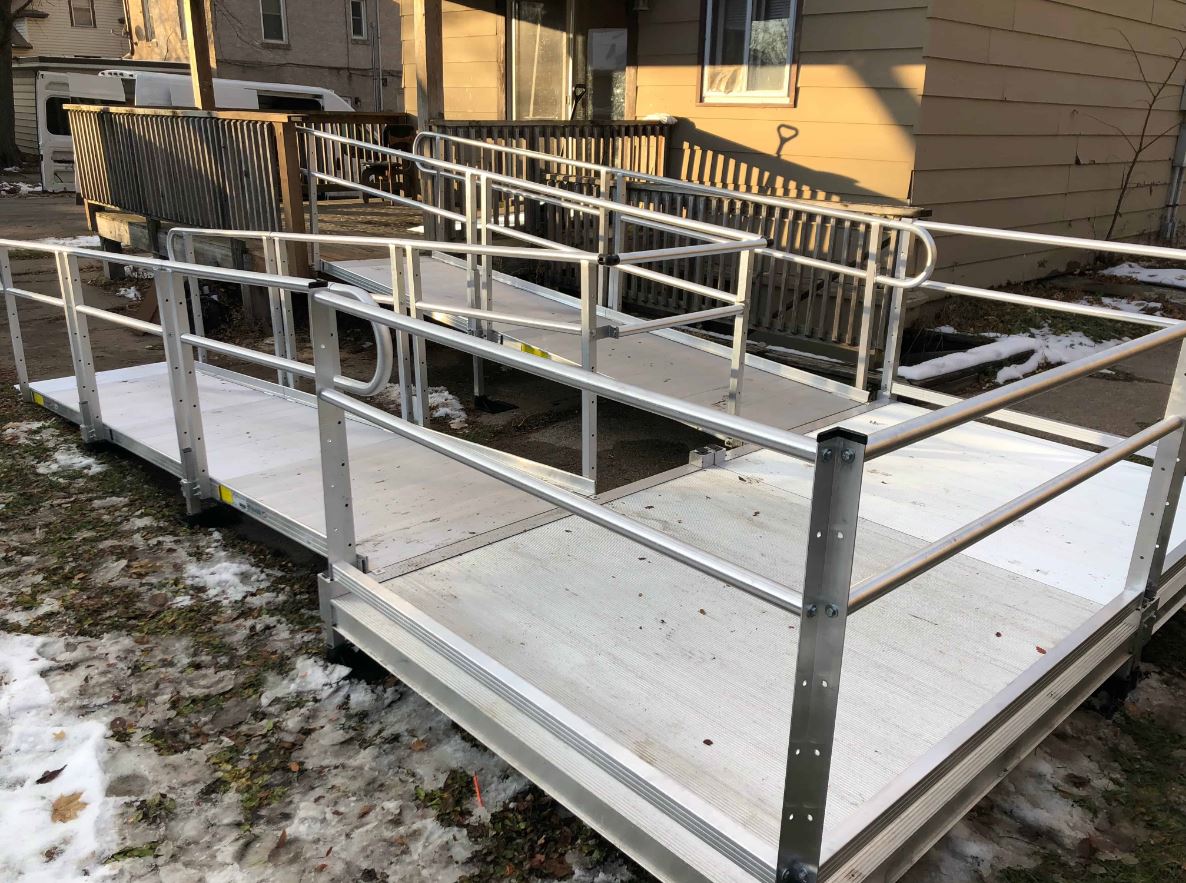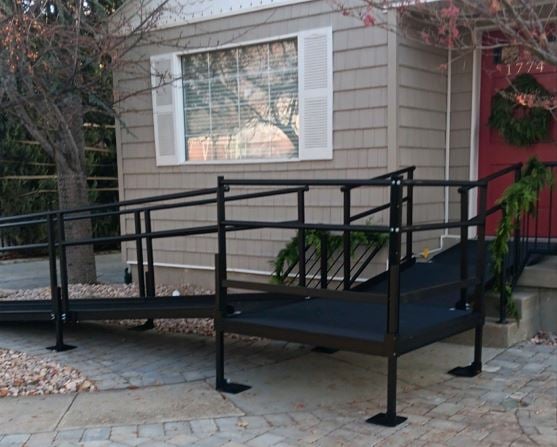Winter Maintenance Tips for Wheelchair Ramps
Posted on by Eric Rubel

If you’re in need of wheelchair ramp, there’s no need to wait for spring to have one installed. In fact, modular aluminum wheelchair ramps can be installed all year round.
Unlike wooden ramps, aluminum wheelchair ramps do not require concrete footers to be poured. Their adjustable legs sit securely on large foot plates that provide a substantial base and sit on top of the surface. This means that they can be installed even when the ground is frozen.
Aluminum Wheelchair Ramps Installed in Winter Weather
 During the winter season, a semi-permanent aluminum wheelchair ramp may be the best option to provide safe access to the entrance of your home. Aluminum ramps are typically maintenance-free and do not rust when exposed to the outdoor winter elements.
During the winter season, a semi-permanent aluminum wheelchair ramp may be the best option to provide safe access to the entrance of your home. Aluminum ramps are typically maintenance-free and do not rust when exposed to the outdoor winter elements.
Like any ramp surface, aluminum can become slippery when covered with snow or ice. However, since the surface is extruded, aluminum wheelchair ramps have superior traction to wooden ramps when wet. Should an aluminum ramp settle between winter and spring, all it takes to level the ramp is a socket wrench.
Winterize Your Wheelchair Ramp - 7 Tips
Those with limited mobility should always exercise caution during the winter months. Below are some tips to make it easier and safer to use a wheelchair ramp throughout the winter.
- Keep your wheelchair ramp clear of snow and sleet by using a thick bristled push broom or plastic snow shovel. You'll also want to clear entry and exit pathways with a shovel to ensure access to the ramp.
- Apply non-corrosive ice melt to prevent ice build up on your wheelchair ramp. If you are unsure if an ice melt is corrosive, select a formula that is safe for pets. The only ingredient that can be in the ice melt for it to be safe to use on an aluminum wheelchair ramp is magnesium chloride. Rock salt should never be used as it can weaken or corrode the aluminum
- Utilize a rubber mat - consider putting down a rubber mat to improve traction. This can be helpful if walking on the ramp or using a wheelchair.
- Heating pads or heat tape - Placing heating pads underneath the mats, or installing heat tape along the seams of the ramp can help prevent ice from forming, and will also help melt snow off the ramp.
- Look into "snow tires" for your wheelchair's wheels - There are some companies that offer traction wheelchair tires, also known as "snow tires" that can provide better tracking through snow and uneven surfaces. Adding these type of tires in the winter can help ensure a safe ride up and down your aluminum ramp in the winter.
- Keep an eye on handrails - the most obvious part of the wheelchair ramp to clean and keep free of snow and ice in the winter is the actual ramping. However, you'll also want to make sure the rails are still tightly secured. If the handrails start to become slippery, you can apply the same type of non-corrosive ice melt on the top of the rails to melt the ice.

Bonus Tip, if you've not yet purchased a wheelchair ramp, but are in need of one for your home:
- Consider powder coating as it will provide an extra layer of protection from corrosive materials, like ice melts. It also allows you to choose from a variety of colors including black, bronze, or tan. It may add to the price of the ramp, but the benefits of it are worth the cost! Something to think about when weighing the costs & benefits of standard aluminum wheelchair ramps vs powder coating aluminum wheelchair ramps, especially in colder climate regions.

Ice Melting Chemical to Avoid Using on Aluminum Wheelchair Ramps
To help extend the life, quality and look of an aluminum ramp, it is strongly recommended to avoid using the following chemical products to melt away snow and ice:
- Rock salt (sodium chloride): This popular de-icer can cause the metal parts to rust, weaken or corrode.
- Magnesium chloride: A rock salt alternative, this chemical can have the same negative effects of rock salt.
- Antifreeze: Not only dangerous and slippery when applied, it simply doesn’t work. Stick to only applying it to cars.
- Metal snow shovels: May scratch the surface of the ramp and allow water or other substances to penetrate the material, which may weaken the ramp’s structural integrity.
- Adhesive texture/anti-slip strips: Any kind of glue may become permanent, and during warm summer months, the glue will show and the ramp will flat out look bad. Anti-slip strips simply can’t take cold weather and their stickiness don’t last when wet. These also may leave behind an undesirable marks when peeled back after the winter season.
Final Thoughts
Don’t let the snow, ice, and cold temperatures prevent you from using or purchasing a wheelchair ramp this winter season! Lifeway Mobility offers aluminum wheelchair ramps for purchase and rental that can be installed year-round. Lifeway's wheelchair ramps are made of a durable aluminum that won't break down in the winter, which also makes it easy to maintain.
Contact us for more information about wheelchair ramps or to set up a free consultation.
